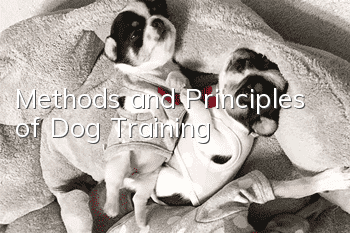Methods and Principles of Dog Training

When training your dog, you must adopt correct training methods and adhere to certain training principles to ensure that your dog quickly develops good and stable living habits and masters various training skills in a short period of time. Training methods: including induction, coercion, prohibition and reward. Induction means that the owner uses the dog's favorite food and items to induce the dog to perform certain actions, or uses the dog's spontaneous actions in combination with commands and gestures to establish conditioned reflexes or enhance the training effect. means.
Forcing refers to a method in which the owner uses mechanical stimulation and threatening tone commands to force the dog to perform corresponding actions accurately. Forced training is mainly used in initial training to strengthen the formation of conditioned reflexes. Under the influence of external incentives, when the dog cannot smoothly follow the commands and gestures, forced methods can also be used. This method must be combined with rewards, that is, every time the dog is forced to perform correct actions, sufficient rewards must be given.
Prohibition refers to a method used by owners to stop their bad behavior. Prohibition is essentially a kind of punishment for dogs. It can only be used when the dog has bad behavior. When the dog delays executing the command, only coercion can be used instead of prohibition. When using prohibitive methods, the attitude must be serious and the tone must be firm, but the dog must not be punished corporally. Stopping must be timely. Stopping is only effective when the dog has the desire to violate the prohibition or in the early stages of the violation. Prohibiting it afterward will not only be useless, but will cause the dog's nerves to become confused and at a loss. After the dog stops violating the prohibition, it should be rewarded immediately to ease the dog's nervous state.
Reward is a means to strengthen the dog's correct actions, consolidate the dog's developed behavior, and adjust the dog's nervous state. Reward methods include feeding food, petting, playing, and verbal praise of "good". Rewards are extremely important in dog training, but they must be used correctly, otherwise, good results will not be achieved.
In dog training, the principle of "step by step, from simple to complex, adapting to the dog's conditions, and treating them individually" must be followed. Training a dog to do every complete action cannot be completed in one go. It must be trained step by step, from simple to complex, and a variety of single conditioned reflexes are combined into a dynamic stereotype. For example, in the "picking" action, it includes a series of conditioned reflexes such as "sitting on the left, going, holding, coming", etc., forming a fixed dynamic stereotype. In the future, as long as the dog hears the "hold" command, it will complete This series of actions.
Since various dogs have different neurological types, personality characteristics and training purposes, during training, dogs should be treated separately according to their conditions. Otherwise, the best training method will be ineffective. For example: Dogs that have a strong reaction to food can be stimulated with more food; ferocious and aggressive dogs should be strictly required to strengthen their obedience and attachment; timid dogs should be trained with a gentle tone and lightness The action is approached and patiently induced. In short, training should be based on the characteristics of the dog.
- How to deworm a poodle?
- What should I do if my puppy keeps barking?
- How long can a Pomeranian live with kidney failure?
- How to practice dog movements and how many months does it take?
- How to care for pet dog hair in the hot summer, a must-read for poop collectors!
- Living habits of Chinese Shar Pei dogs
- How much dog food should a two-month-old puppy eat?
- Close contact with dogs, four tips for getting rid of dog bad breath!
- How to choose dog food for elderly dogs
- How many minutes does it take for a puppy to nurse?



